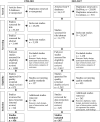Evidence-Based Practices for Children, Youth, and Young Adults with Autism: Third Generation Review
- PMID: 33449225
- PMCID: PMC8510990
- DOI: 10.1007/s10803-020-04844-2
Evidence-Based Practices for Children, Youth, and Young Adults with Autism: Third Generation Review
Erratum in
-
Correction to: Evidence-Based Practices for Children, Youth, and Young Adults with Autism: Third Generation.J Autism Dev Disord. 2023 Jan;53(1):514. doi: 10.1007/s10803-022-05438-w. J Autism Dev Disord. 2023. PMID: 35059951 Free PMC article. No abstract available.
Abstract
This systematic review describes a set of practices that have evidence of positive effects with autistic children and youth. This is the third iteration of a review of the intervention literature (Odom et al. in J Autism Dev Disorders 40(4):425-436, 2010a; Prevent School Fail 54(4):275-282, 2010b; Wong et al. in https://autismpdc.fpg.unc.edu/sites/autismpdc.fpg.unc.edu/files/imce/documents/2014-EBP-Report.pdf ; J Autism Dev Disorders 45(7):1951-1966, 2015), extending coverage to articles published between 1990 and 2017. A search initially yielded 31,779 articles, and the subsequent screening and evaluation process found 567 studies to include. Combined with the previous review, 972 articles were synthesized, from which the authors found 28 focused intervention practices that met the criteria for evidence-based practice (EBP). Former EBPs were recategorized and some manualized interventions were distinguished as meeting EBP criteria. The authors discuss implications for current practices and future research.
Keywords: Autism spectrum disorder; Children and youth; Evidence-based practice; Focused intervention.
© 2021. The Author(s).
Figures
References
-
- American Speech-Language-Hearing Association. (2004). Evidence-based practice in communication disorders: an introduction [Technical Report]. www.asha.org/policy.
-
- Ayres AJ. Sensory integration and the child: Understanding hidden sensory challenges. Los Angeles: Western Psychological Services; 2005.
-
- Brown, L. (2011). Identity and hypocrisy: a second argument against person-first language, November 28. Available at http://www.autistichoya.com/2011/11/identity-and-hypoc-risy-second-argum... (accessed March 15, 2020).
Publication types
MeSH terms
Grants and funding
LinkOut - more resources
Full Text Sources
Other Literature Sources
Medical
Miscellaneous





